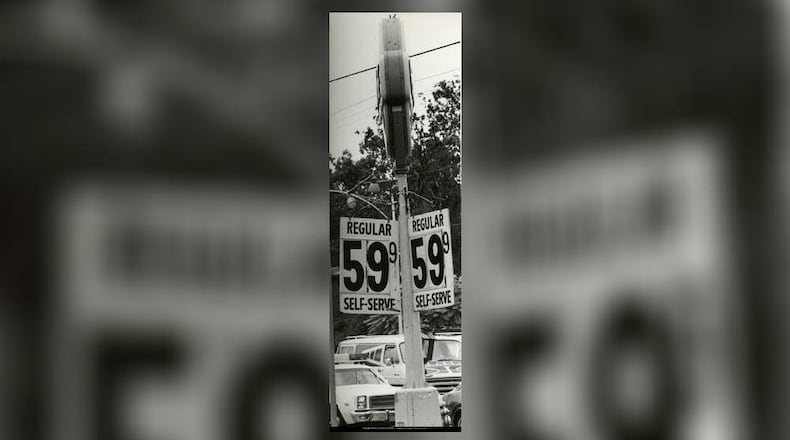Now that Gov. Brian Kemp has signed House Bill 304, suspending Georgia’s 29.1 cents-a-gallon motor fuel tax through May 31, the state’s loss will be its drivers’ gain.
The temporary relief for consumers came about after gasoline prices surged past $4 per gallon in the wake of Russia’s invasion of Ukraine.
“Based on previous years’ collections, (the suspension) would save drivers more than $300 million in taxes,” the Journal-Constitution’s James Salzer reported March 18. “Kemp said the loss of revenue would be made up with surplus state funds.”
There was no talk of gas tax suspension in the early ‘70s, when Atlantans were alarmed at the prospect of gas prices rising due to a fuel shortage.
“How much the gasoline will go up, nobody knows,” the AJC’s Leonard Ray Teel told readers in a March 25, 1973, article. “But guesses are that the price could go up to 44.9 cents for premium to as much as 50, 60 or even $1 a gallon.”
In 1973, the average price per gallon of gas was 39 cents.
Despite the anxiety over the possibility of $1 gas, unleaded regular didn’t reach that price in the South until Nov. 1979, when the Iran hostage crisis started, according to the U.S. Bureau of Labor Statistics.
Or did it?
Constitution staff writers Barry King and Sharon Bailey’s July 13 story from that year, headlined “Gas Goes Over $1 A Gallon In Much Of South” claimed the $1 mark was hit months sooner, noting Tampa, Fla., premium selling for as much as $1.05 and Jackson, Miss., customers paying $1.009 for premium.
Credit: ArLuther Lee
Credit: ArLuther Lee
>> MORE DEJA NEWS: Check out what we’ve covered before (and again)
Closer to home, one Georgia gas station hitting the $1 mark found itself shamed for doing so.
“A service station in Augusta listed premium prices at $1.014 until a local radio station broadcast the increase in news reports,” the Constitution told readers. “The station dropped its price back to 99 cents a gallon because the station operator said he couldn’t stand the bad publicity.”
In Atlanta, however, premium averaged a comparatively cheap 95.1 cents.
Besides pricing, metro Atlanta drivers in summer 1979 had another mounting concern: keeping track of which service stations were open and when.
“Ten percent … are open 24 hours a day; 44 percent are open until 8 p.m. weekdays; 64 percent are open Saturday until 6 p.m.; and 36 percent are open Sunday,” Bailey and King wrote.
If the average metro consumer wasn’t getting headaches trying to follow price changes or remember if the local station was open, he or she could risk migraines upon learning that a station might not even have full pumps.
“The Georgia Motor Club reported that 6 percent of the stations are limiting sales,” the article cautioned, “and 8 percent have run out of at least one grade of fuel in metro Atlanta.”
ABOUT DEJA NEWS
In this series, we scour the AJC archives for the most interesting news from days gone by, show you the original front page and update the story.
If you have a story you’d like researched and featured in AJC Deja News, send an email with as much information as you know. Email: malbright@ajc.com. Use the subject line “AJC Deja News.”
About the Author
Keep Reading
The Latest
Featured



